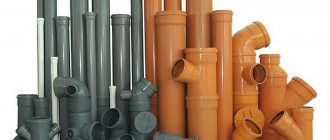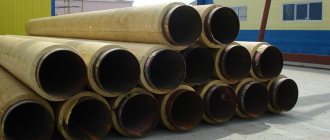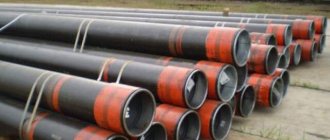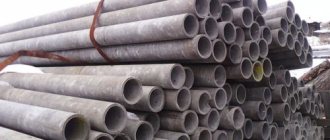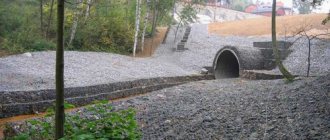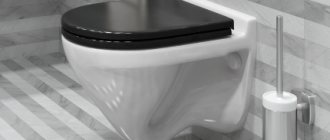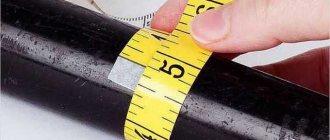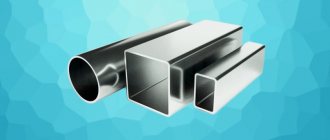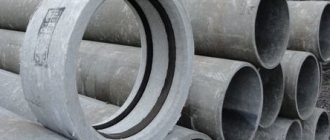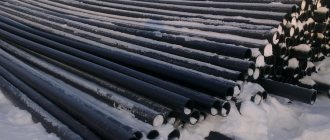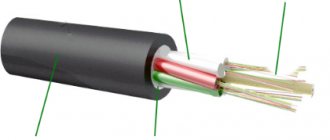High-quality components and pre-insulated pipes for heating networks are a guarantee of long-term operation of communications in any climatic zone. The very technology of production of these products and qualified installation in compliance with the technology ensures flawless operation of the heating network for a long time without the need for repairs.
Pre-insulated pipes are indispensable products for laying heating mains
Pre-insulated pipe manufacturing technology
Pipes pre-insulated with polyurethane foam consist of the following structural layers:
- Straight-seam welded steel pipe providing the main operational characteristics of the pipeline. Mains made of this material can be used when laying heating networks, water supply, including hot water, oil and gas pipelines. The operating pressure of transported liquids or gases can reach 16 atmospheres or more.
- Not so long ago, exclusively galvanized sheet steel was used as the outer shell, which protects the system from external factors that cause corrosive processes. Recently, pre-insulated pipes for heating networks are produced using an outer shell made of low-density polyethylene (HDPE). This material has a low specific gravity, it is resistant to various aggressive environments, and does not corrode and rot. Thanks to this, pipes with such a coating can be used for laying underground and above-ground pipelines for various purposes.
- Polyurethane foam, considered one of the most effective heat insulators, is pumped between the inner and outer pipes. Its use makes it possible to reduce heat losses in heating and hot water supply networks by almost a quarter. In addition, polyurethane foam reliably protects the highway from the effects of negative temperatures, even when laid on the ground.
Flexalen, Flexalen
This is a relatively new unique product in the field of thermal insulation. This material is a ready-made heating main , a ready-made heating network pipeline, combining the excellent characteristics of polymer pipelines and high-quality thermal insulation.
Due to reliability, durability and speed of installation, pre-insulated pipelines are of particular interest when laying external heating networks, cold and hot water supply in cottage villages with central boiler houses, in private summer cottages between buildings, for the reconstruction and arrangement of urban heating networks, as well as for transportation of food and industrial liquids.
Due to the flexibility of pre-insulated pipes, they can be laid in a route of up to 300 m in any configuration without a single connection or the installation of a special channel and compensators. It is also possible to lay directly on the surface of the earth or above-ground installation in places where it is not possible to carry out excavation work. The optional configuration of pipelines with a heating cable operating in automatic mode makes it possible to carry out channelless installation at a shallow depth, on the surface of the ground or above the ground in places where it is not possible to carry out excavation work.
The use of one-piece uniform (homogeneous) welded joints does not require access (inspection control) to the joints of pipelines in the ground, which avoids the construction of expensive installation wells. Thus, unlike traditional heating mains, the connections of Flexalen pre-insulated pipe systems are maintenance-free .
Diagram of pre-insulated pipes
Polybutene is a unique material that combines the advantages of pipes made from cross-linked polyethylene PEX and polypropylene PP, and surpasses them in a number of basic parameters. Polybutene used for the production of feed pipes has excellent hygienic properties and is widely used in the food industry.
2. Thermal insulation made of physically foamed (gas-filled) polyethylene Thermaflex
The gas used to foam the insulation has a thermal conductivity of 0.0137 W/mK at 10°C, which is half that of air. Thermal insulation has a continuous homogeneous layer and has a closed cellular structure.
3. High strength corrugated protective casing
Made of low-density polyethylene with the addition of carbon. The casing is resistant to ultraviolet radiation, which allows the use of insulated pipelines for above-ground installation.
Listed below are just some of the advantages of FLEXALEN pre-insulated pipes over traditional engineering heating and water supply systems:
• HIGH ENERGY EFFICIENCY. Thanks to the use of polybutene piping and high-performance insulation, pre-insulated ductless piping systems have minimal heat loss.
• PIPELINE PIPE IN PIPE - COMBINATION OF SEVERAL PIPELINES IN ONE CASING. This feature significantly simplifies and reduces pipeline installation time.
• CHANNELESS PIPELINE. They allow for channelless installation, as well as laying on the ground, which significantly reduces installation costs.
• DO NOT NEED COMPENSATORS. Insulated pipe systems are self-compensating.
• STRENGTH and FLEXIBILITY. Due to their flexibility and water resistance, they can be used even in unstable moving soils; The high elasticity of insulated pipelines allows complex long sections of pipelines to be passed with a minimum number of connections, which increases the reliability of the system.
• HIGH RELIABILITY OF CONNECTIONS. Polybutene pipes can be installed using both traditional compression mechanical fittings and highly reliable one-piece polybutene fittings for electrofusion and socket welding, i.e. When laying insulated pipelines, there is no need to install special wells to provide installation access to the pipeline connections in the ground.
• EXTRA LONG LIFETIME. Unlike traditionally used heating main pipes, subject to the recommended installation and operating conditions, the service life of Flexalen exceeds 50 years.
• ANTI-CORROSION PROPERTIES. Flexalen pipelines, consisting of polymer materials, are not subject to corrosion.
• LOW WEIGHT. The materials used in Flexalen flexible pipe systems with thermal insulation have low density and, as a result, low weight, which makes the piping system extremely light and easy to handle, both during transportation and storage, and during installation.
• RESISTANCE TO AGGRESSIVE LIQUIDS. Polybutene pipes can transport not only water, but also liquids for food and industrial purposes.
• SMOOTH INNER SURFACE OF PIPES. Does not create an abrasive effect. Hydraulic losses when transporting liquids are significantly reduced, since the roughness of the inner surface of the pipe is extremely insignificant.
• ENVIRONMENTAL SAFETY. FLEXALEN insulated insulated pipelines are safe for the environment, as they are made from recycled, non-toxic raw materials.
Main types of FLEXALEN pipelines
| Single pipe water supply system | Pre-insulated pipes FLEXALEN 600The system includes one or two pressure pipes, framed by a continuous and uniform layer of highly effective thermal insulation. In a single-pipe system, the diameter of the pipelines can range from 16 to 125 mm, in a two-pipe system - from 16 to 63 mm. Purpose: Arrangement and installation of external engineering systems for heat supply (heating) and hot and cold water supply, as well as transportation of food and industrial liquids. |
| FLEXALEN 600 Two-pipe system (water supply) | |
| Single pipe system (heating) | |
| FLEXALEN 600 Two-pipe system (heating) | |
| FLEXALEN 600 Single pipe system with heating cable | |
| Flexalen 1000+ Multi-pipe system | FLEXALEN 1000+ Multi-pipe pre-insulated pipelines consisting of polybutene pipes in thermal insulation made of polyethylene foam, as well as a protective corrugated plastic casing made of HDPE with the addition of carbon. One casing may contain heating pipes and hot water pipes. Purpose: laying external heat supply (heating) and hot water supply networks. The number of pipes in one casing varies depending on the project requirements. |
Production of pre-insulated pipes
The production of pre-insulated pipes is carried out on modern automated lines with quality control and adherence to technology at each stage:
Production of pre-insulated pipes
- Steel pipes undergo shot blasting, which removes scale and rust and gives the surface a certain relief. This roughness provides better adhesion between polyurethane foam and steel.
- The steel blank is placed in a polyethylene case and fixed so as to ensure the same thickness of insulation throughout the entire cross-section of the structure. The length of the outer HDPE casing is slightly less than the size of the pipe; both ends of the product are not covered by 15-20 cm. This is done to ensure welding of the pipeline.
- The resulting blank is filled with polyurethane foam and left until the insulation has completely hardened.
For laying pipelines in particularly difficult climatic conditions, pre-insulated pipes with a heating cable are used, which provides active protection of the pipeline from freezing. Cable winding is carried out immediately after preparing the steel pipe after shot blasting.
Technology and design
To ensure high strength of the connection between the pipe and the heat-insulating layer, its surface is subjected to shot blasting. In addition to removing rust and dirt, this produces a rough texture. For the same purpose, the protective shell is treated with a coronary discharge from the inside.
Then the pipe is placed on the assembly table, controlling its position with centralizers and SODK. Then, using a winch, it is moved inside the outer shell and sent along a conveyor to a heat chamber. The hot air supplied by the fan heats the pipe to 350 ⁰C. To ensure uniform temperature distribution, it is forced to rotate. Plugs with holes for air outlet are installed at both ends. They are secured with screws so that the liquid composition does not leak out from the space between the pipes.
The parameters for the formation of the heat-insulating layer are set on the filling machine console. Their values depend on the type of raw material, length and shape of the product. Liquid polyurethane foam is quickly injected using a watering can. After it has hardened, the structure is sent for quality control. Upon completion of certification, the pipes are marked and packaged.
Properties of penoizol
In appearance it is similar to polystyrene foam, but has completely different qualities. In terms of basic characteristics, it is practically not inferior to polyurethane foam, but it costs less and the technology for creating a heat-insulating layer is simpler, since heating is not required. The composition is prepared from urea resin, foaming agent, hardener, and water. After foaming with compressed air, it is poured under pressure into the space between the pipes.
Penoizol is often used in the production of pre-insulated products, as it has many advantages:
- High strength. You can walk on it without causing damage.
- Light weight.
- Low thermal conductivity.
- Good vapor permeability, so mold does not form on it.
- Preservation of shape and quality when wet and subsequent drying.
- Long service life - from 70 years.
Sometimes there are pipes insulated with foam plastic, flexible varieties covered with foamed polyethylene, and others. However, in all respects they are inferior to the types under consideration, and are more expensive, so they are not widely used.
Types of pre-insulated pipes
Manufacturers produce three modifications. Pre-insulated products are:
- Tough. A standard version in which the thickness of the heat-protective layer depends on the conditions of use. For northern regions it is made from 10 cm, in warm areas - up to 5 cm. The protective layer is made of metal tape, sometimes stainless steel is used. Pipes of this type are used for installation of main and high-pressure communications in industry, risers in high-rise buildings.
- Flexible. The products differ from the previous type in that instead of metal tape, corrugated plastic is used to create a protective layer. This allows steel strands to be laid with a small radius. Flexible plastic pipes can be bent at the desired angle and even twisted. If the insulation layer is damaged, this will not significantly affect the functioning of the system. They are produced in coils up to 100 m long.
- With combined wiring. These varieties have several polymer pipes placed under a common thermal insulation layer. In this design they are reliably protected from freezing and mechanical damage. Combining several pipes allows you to install compact branched systems with significant savings in insulation. But if one of them is damaged, you need to remove the protective layer from all of them. And first you have to tinker with determining the location of the gust.
Reputable manufacturers produce a full range of protected connecting elements for their pre-insulated pipes.
Advantages of pipes with PPU pre-insulation
Experts primarily highlight the following advantages of such pipes:
- The average service life reaches 30 years.
- Operating costs for repairs and maintenance of the highway are significantly reduced.
- Pre-insulated pipelines help minimize thermal energy losses when transporting various liquids.
- High resistance to aggressive substances contained in groundwater.
- The ability to avoid additional waterproofing treatment of the pipeline, which allows reducing the cost of installation work.
- Laying pipes of this type is carried out by a team of welders; the use of special equipment is not required.
It is these performance qualities that have become the reason for the increase in the volume of laying pre-insulated pipes when installing urban communication networks for various purposes.
Installation of pre-insulated pipes
Unfortunately, it is still possible to encounter a situation in which a pre-insulated steel pipe at the joints is insulated with traditional materials (glass wool, mineral insulation). This approach to installation cannot be called rational.
Installation of pre-insulated pipes
It is possible to obtain high-quality insulation of the pipeline only by assembling the pipeline using heat-shrinkable sleeves made of HDPE. Thanks to their use, it becomes possible to obtain almost monolithic thermal and waterproofing of the entire pipeline.
Installation of pre-insulated pipes using this technology is carried out as follows:
- A heat-shrinkable sleeve, which is a piece of HDPE pipe of the appropriate diameter, is placed on one of the pipes being connected. In this case, it must be moved at least 50 cm from the edge of the pipe.
- After the installation of the joined pipes has been completed (alignment, welding gap between the ends), welding work is performed. When installing heating mains and water supply lines, electric or gas welding is used. Upon completion of the work, it is necessary to ensure the quality of the welded joint and allow the joint to cool.
- The heat-shrink sleeve moves to the working position (it should completely cover the uninsulated edges of the two connected pipes).
- The coupling is heated by the flame of a welding gas torch, and it is necessary to heat from the middle to the edges of the element. Do not overheat or burn the surface of the coupling.
- Under the influence of temperature, the coupling contracts and tightly covers the pipe insulation layer.
- The final step is to fill the coupling with polyurethane foam.
The use of steel pipes with polyurethane foam pre-insulation and heat-shrinkable couplings is considered the most rational and promising for laying main pipelines for various purposes.
Source
Areas of use
The products are used for installation of sewerage, water supply and heating networks. Due to their good security, they are often used for transporting gas and oil products. During the period of major repairs of heating networks, they replace old pipes.
Internal installation is carried out using plastic varieties if the water temperature does not exceed 95 ⁰C. Air routes, large-diameter main communications and networks with coolant temperatures up to 150 ⁰C are installed from steel types. Both types can be laid using the channelless underground method.
Flexible long plastic products are more expensive than steel varieties. However, the construction of a small-diameter pipeline with a large number of turns from them will be cheaper. This is because installation does not require expensive fittings and compensators. By speeding up installation, labor costs are reduced and there is no need for repair work caused by corrosion.
PPU pipes - what are they?
Pipes in polyurethane foam insulation (PPU insulation) are a structure made according to the “pipe-in-pipe” principle, i.e. consists of two pipes: the inner working (bearing) and the outer protective (shell), the gap between which is filled with polyurethane foam.
In a nutshell, a PPU pipe is a steel pipe that has additional protection in the form of a heat-insulating layer, the functions of which are performed by polyurethane foam. A protective waterproofing shell made of polyethylene or galvanized steel extends the trouble-free service life and expands the scope of application.
What is the difference between pre-insulated pipes and others?
These products are similar to chimneys made using sandwich technology. In general, pre-insulated structures look like one or more cylinders placed in a shell of a larger diameter. The space between them is filled with synthetic filler. The most commonly used is polyurethane foam (PPU).
The central tube is made of steel, but there are varieties with one or more of plastic. To protect the polyurethane foam layer from getting wet and mechanical damage, galvanized metal tape or polyethylene is used. Inside there is a special wire that allows you to monitor the state of the system and quickly identify emerging defects. Through the use of special technologies, a strong connection between the layers is ensured. The result is a solid product, not a set of elements.
PPU pipe production technology
- The production of polyurethane foam pipes is possible only in factory conditions, where polyurethane foam is sprayed onto a steel pipe, which in turn is covered with a galvanized steel shell or a layer of polyethylene (in a polyethylene shell). The procedure for manufacturing pipes is regulated by GOST 30732-2001. The standard was finally approved and recommended for use only in 2006, so the name of the PPU pipe GOST 30732 2006 is often found. It is worth noting that the standards of the standard apply only to PPU PE. The production of polyurethane foam pipes in a galvanized shell is not regulated;
- insulation of pipes with polyurethane foam insulation. It involves applying polyurethane foam to the pipe or packaging it in a polyurethane foam shell. Application of polyurethane foam is a more popular option for pipes in use, because... it becomes possible to insulate already installed pipelines. In addition, insulating pipes with polyurethane foam is a more economical option.
- PPU shells for pipes are a shell made of polyurethane foam, consisting of one, two or several parts (cylinder, half-cylinder, prefabricated elements). Dimensions of the polyurethane foam shell: length 1 m., thickness varies. The use of shells makes it possible to insulate a pipe without the use of polyurethane foam spraying equipment. The installation technology involves fixing the PU shell on the pipe using ties.
Stages of production of polyurethane foam pipes
To understand what determines the high performance properties of pipes in polyurethane foam insulation, let’s briefly consider how their production takes place:
- input control. Incoming raw materials and other components are checked for compliance with standards: polyethylene, polyurethane foam system, steel, UEC sensors, etc.;
- production of polyurethane foam shell;
- installation of a steel pipe in a shell. Also includes installation of UEC conductors;
- polyurethane foam filling;
- outgoing control. All products must be tested for compliance with norms and standards.
These are the stages of the production cycle that pipes go through at large domestic factories.
The production process is regulated by standards:
Main manufacturers of polyurethane foam pipes
- LLC "MTER TsTS" ("Mezhregionteplosetenergoremont TsTS") (Moscow) is considered the leader in Russia in terms of the volume of produced polyurethane foam pipes;
- LLC "Tatteploizolyatsiya" ("TTI"), Republic of Tatarstan. It is one of the four largest enterprises producing polyurethane foam pipes in the Russian Federation. The production uses equipment from KWH (Finland), which allows the production of over 1,700 m.p. per day.
Also among the large regional manufacturers are:
- LLC "ZTI" (Thermal Insulation Plant), St. Petersburg;
- LLC "SKTK" (Moscow);
- SZTGC - North-West Pipe Waterproofing Company (St. Petersburg);
- Pervouralsk pipe insulation plant (Ekaterinburg);
- (Saint Petersburg);
- LLC "Bizol" (Chelyabinsk);
- CJSC "UZTI" ("Ural Thermal Insulation Plant"), Sverdlovsk region, Polevskoy.
The listed factories confirm the quality of polyurethane foam pipes and components with certificates and test reports.
PPU pipe design (device)
Diagram of the installation of polyurethane foam pipes with a polyethylene and galvanized shell.
The insulated pipe consists of three layers:
- main (working) steel pipe . Pipes are used that meet the requirements of GOST 3262-78, 8732-78, 10705-80, GOST 30732-2006, SNiP 3.05.03-85;
- thermal insulation material – polyurethane foam insulation . Thermal insulation is provided by spraying polyurethane foam. This innovative material differs from traditional insulators (for example, glass wool) by its low thermal conductivity, hygroscopicity, and durability. Thermal insulation material must comply with GOST 30732-2006. In this case, an important requirement must be met - good adhesion to the material of the working pipe and shell. Permissible displacement (axial shift) – 0.14 MPa (t=23°C);
- PPU insulation shell . As such, black low-pressure polyethylene is used (regulated by GOST 18599-2001) or galvanized (regulated by GOST 52246-2004) - a steel protective shell (made of galvanized strip). The type of shell is noted when marking the product;
- ODK system (this is an integral part of more advanced types of pipes). PPU pipe with ODK (SODK) is a pipe in polyurethane foam insulation, which is equipped with an online remote control system.
Installing the UEC makes it possible to receive information in real time about possible defects:
- damage to the main pipe;
- damage to the shell pipe;
- malfunction of the signal wire;
- incorrectly installed joints of polyurethane foam pipes (wires are poorly connected to each other).
UEC allows you to monitor the condition of the pipeline in a specific section or along the entire pipeline route.
Note. ODK is mounted in polyurethane foam pipes in a polyethylene sheath. As for pipes encased in galvanized steel, in this case the availability of UEC is discussed with the customer. And the specificity of installing copper control wire is that there are three, not two, signal wires.
Scope of application of polyurethane foam pipes
- laying heating networks (hot water supply systems, heating and heating mains);
- laying water supply systems and water pipelines;
- laying industrial networks;
- gas production industry (gas transportation);
- oil refining industry (transportation and processing of petroleum products).
Types by design
There are currently two main types of pre-insulated pipes on the market:
- hard;
- flexible.
Products of the first type are made of ordinary or galvanized steel with polyurethane foam insulation. The outside of such pipes is sheathed with sheets of hard steel or stainless steel.
Flexible products of this type are manufactured using similar technology. However, such pipes are covered not with steel, but with corrugated plastic. Of course, such products are not very flexible. After all, polyurethane foam is a material itself that is quite rigid and not too elastic. However, it is still possible to slightly bend this type of pipe during installation.
Of course, in the manufacture of plastic shells of pre-insulated pipes, GOST standards are also compulsorily observed. The highest quality light-stabilized material is usually used for their assembly.
Sometimes protective shells with an insulating layer can be supplied separately from the pipes themselves. In this case, before their installation, when assembling the pipeline, the pipes are first checked for leaks and then coated with an anti-corrosion compound.
Types of pipes with PPU insulation
The wide scope of application and the possibility of using different materials to form the protective outer shell of the pipe makes it possible to manufacture two of the varieties. Information about the purpose and composition of the pipe is contained in the marking. There are types and types:
- PPU pipe in a polyethylene sheath (PPU PE pipe) . In this case, polyethylene is used to protect the thermal insulation material. Designed for installation in underground ductless and channel pipelines. Some manufacturers label this type as St PPU PE pipes, which means that the working pipe is a steel pipe with a polyethylene shell;
- PPU pipes in a galvanized shell (PPU pipe OTs) . The function of protecting the insulation is delegated to galvanized material, which is wound into a casing (shell, case). They are used for overhead laying of pipelines (aerial laying). In this case, polyethylene is unable to perform protective functions, because is destroyed under the influence of ultraviolet radiation and other external factors. A galvanized steel shell provides better protection in these conditions.
Pipes also differ depending on the thickness of the insulation used in them:
1 PPU – standard type of insulation. Suitable for laying in regions with temperate climates. In this case, the pipes are marked as follows: 1 PPU PE (in a polyethylene sheath) or 1 PPU OTs (in a galvanized sheath);
2 PPU – reinforced type of insulation. Designed for areas with cold climates. Products are designated 2 PPU PE or 2 PPU OTs.
PPU pipe marking
Marking example:
PPU pipe st. 57x3-1 PPU-PE with ODK GOST 30731-2006
It stands for: pipe with polyurethane foam insulator, steel, outer diameter is 57 mm, steel wall thickness is 3 mm, PPU type - insulation of the first type (1 PPU), polymer shell (PE), the pipe is equipped with an operational remote control system (ODC). Manufactured in accordance with the requirements of GOST 30731-2006.
Conditions for storing and transporting finished pipes
Mechanical damage, longitudinal bending, deformation, and contamination are not allowed. Dropping, rolling, hitting pipes, or dragging on the ground is prohibited. Transportation of pipes is carried out by rail, water or road transport in accordance with the rules for the transportation of goods, ensuring the safety of the insulation and eliminating the occurrence of longitudinal deflection. Loading and unloading operations are carried out in the temperature range specified for construction and installation work, but not lower than:
- -18 °C - for pipes with a polyethylene sheath;
- -50 °C - for pipes with a steel protective shell.
Shaped products for PPU pipes
Installation of polyurethane foam pipes is carried out using shaped products.
The most popular of these are:
- steel pipes PPU;
- bends, elbows, bends;
- PU shell;
- heat-shrinkable cuffs (allow you to ensure the tightness of the pipe junction);
- PPU pipe supports;
- fixed supports. Allows you to ensure the stability of the pipe on a straight section of the heating main;
- sliding supports. Used when installing pipes by air (ground) method. The sliding support allows the pipe to move, compensating for expansion caused by external factors.
This variety of shaped elements allows for the installation of systems of varying complexity and reliable connection of pipes to each other.
PPU pipe sizes
Metrological parameters of polyurethane foam pipes (dimensions, diameters)
PPU pipes - dimensions (diameter, wall thickness and shell)
Metrological parameters of polyurethane foam pipes (gradation by type)
Geometric parameters of polyurethane foam pipes GOST 30732-2001 standard shell (TYPE-1) and reinforced shell (TYPE-2)
Pipes in PPU insulation made of polyethylene (PE)
Size range. Outer diameter from 32 mm to 1020 mm, inner diameter 25-1000 mm, wall thickness 2-11 mm, PE shell diameter for 1-2 types of polyurethane foam 90-1200 mm, polyethylene shell thickness 3.0-14.9 mm.
Dimensions of polyurethane foam pipes in a polyethylene sheath (diameter, wall thickness and sheath)
Pipes in polyurethane foam insulation made of galvanized steel (OTs)
Size range. Outer diameter from 32 mm to 530 mm, inner diameter 25-500 mm, wall thickness 2-7 mm, diameter of the OC shell for 1-2 types of polyurethane foam 100-710 mm, thickness of the galvanized shell 0.5-0.7 mm.
Dimensions of polyurethane foam pipes in a galvanized shell (diameter, wall thickness and shell)
Technical characteristics of polyurethane foam pipe
| No. | Index | Value/dimension |
| 1 | Density | 40-60 kg/sq.m. |
| 2 | Strength (permissible load) | 200 kg/m3 |
| 3 | Coefficient of thermal conductivity | 0.025-0.032 W/m*K |
| 4 | Hygroscopicity (water absorption) | 0.1-0.2 kg/sq.m. per day |
| 5 | Flexural strength | 1.5 kg/sq.cm |
| 6 | Working pressure, maximum | 1.6 MPa |
| 7 | Media operating temperature, maximum | 130 °C |
| 8 | Peak media temperature, maximum | 150 °C |
| 9 | Heat loss, maximum | 4 % |
Performance characteristics of polyurethane foam pipe
| No. | Index | Value/dimension |
| 1 | Minimum laying depth for channelless installation | 500-700 mm |
| 2 | Maximum laying depth | 3,000 mm |
| 3 | Reducing the installation time of heating systems when using polyurethane foam pipes in comparison with traditional pipes | 3 times |
| 4 | Reducing the cost of servicing heating networks with polyurethane foam pipes | 9 times |
| 5 | Reducing the cost of repairing heating systems with polyurethane foam pipes | 3 times |
| 6 | Estimated service life | 30 years |
Polyurethane foam pipes are of interest to housing and communal services, industrial and oil refining enterprises; they are unlikely to be useful in private households.
Cost of PPU pipes
For those wishing to buy or get an idea of the cost of polyurethane foam pipes and shaped elements, we provide approximate prices
Price list for PPU pipes SZTGK (North-West Pipe Waterproofing Company)
Studying the products of different manufacturers, it is not difficult to notice that on the website of each of them there is a price list for polyurethane foam pipes. However, it should be understood that this price is not final, because it is derived from many factors and is constantly being revised. In the case of significant volumes of purchases, the price is subject to negotiation.
Buy insulated flexible plastic pipes for heating mains
The development of innovations in the production of heat supply equipment has made it possible to actively use flexible pipes for heating mains. They replaced old metal structures, which had many disadvantages:
- were placed in improperly equipped channels,
- did not retain heat well
- emergency leaks were constant companions of their work.
Metal pipelines were exposed to the harsh Russian climate and corrosion, and the insulation quickly lost its properties.
The flexible heating main has solved numerous problems; its elements are made of durable plastic, not subject to atmospheric influences and a much cheaper material than metal. Buying underground pipes for installing a heating main means establishing the supply of thermal energy without losses and saving on repairs.
Pre-insulated plastic pipes
Flexible insulated heating mains are made of cross-linked polyethylene or other types of high-strength polymer materials. Foamed polyethylene with a closed structure in the form of pores, protected by a special shell, is used as thermal insulation. The polyethylene casing is a moisture-proof casing that houses one to four insulated pipes.
Polyethylene is a very durable material, so polyethylene pipelines can be laid to a depth of up to 6 m without installing an additional tray. Plastic communications have become an excellent alternative to steel pipelines, and are used not only for heating large industrial facilities, but also for supplying heat to private houses and other buildings.
Their service life is 50 years, which significantly exceeds the service life of metal pipeline systems.
Advantages of flexible polymer products in insulation:
- flexibility, which allows you to avoid obstacles during installation and not use additional fasteners;
- absence of corrosion, as a result, the originally intended permeability of the coolant is preserved;
- flexible pipes installed in insulation are five times lighter than their steel counterparts;
- reducing the time of trouble-free operation of heating networks;
- cost savings: the use of innovative materials reduces the cost of the project by 10%.
Installation is much simpler than assembling steel products. Fittings and other connecting parts are selected for each set of plastic pipelines in production. The system is mounted like a construction kit, quickly and firmly. An additional advantage of using pipes for installing heating mains in reliable insulation is the low prices for these products.
Isoproflex (Isoplex)
"Isoplex" is used for:
- technical complexes of hot and cold water supply,
- for supplying drinking water,
- in the process of constructing swimming pools and refrigeration units.
Laying a lightweight plastic pipe for a heating main does not require compensators, bends or fixed supports. Buying a pipe for laying heating mains of this type means making heating systems reliable and trouble-free.
Isoproflex installation technology
Casaflex
Pre-insulated plastic products of the Casaflex brand are used for installation of open and closed heating systems without the use of a duct. Laying routes from these components does not require special equipment or additional equipment. Casaflex products can withstand temperatures up to 160 degrees, short-term heating can reach 180 degrees, and also do not require long-term scheduled heat outages.
Casaflex installation technology
Prices for pipes for heating networks
On our website you can find detailed descriptions and price lists for all types of products. The cost of pipes varies depending on their number in the casing and technical characteristics. Prices at TK Flex are among the most affordable on the market. We are also pleased to inform you about the discounts, bonuses and special offers we provide.
Download price
Advantages of pipes with PPU insulation
- polyurethane foam insulation of pipes can significantly reduce heat loss. The maximum heat loss is only 4%, while steel pipes with traditional thermal insulation have heat loss in the range of 20-25%;
- high degree of reliability;
- reduction of heat loss during coolant transfer by 35-40%;
- temperature resistance. Applicable in the range of external temperatures from -80 to +130 °C;
- resistance to moisture;
- non-corrosion without additional treatment;
- high laying speed. Installation of polyurethane foam pipes is carried out above-ground, underground and channel methods. Underground channelless installation to a depth of up to 1 m is possible. This installation method involves installing the pipeline directly in the trench; there is no need to use reinforced concrete trays;
- environmental Safety;
- significant reduction in costs for construction, maintenance and repair of heating mains;
- the ability to monitor the state of the system (due to the presence of an online remote monitoring system);
- anti-vandalism. Thermal insulation from polyurethane foam pipes is almost impossible to steal and reuse;
- increasing the service life of the heating main.
In conclusion, we note that pipes with polyurethane foam insulation are a new type of insulated pipe material that has a significant list of advantages, has a reasonable price/quality ratio and has a long service life.
Source
Product quality requirements
All processes for producing pipes with polyurethane foam are carefully controlled for compliance with standardization standards. For example, foaming and hardening of polyurethane foam is a fast process where deviations from the norms are unacceptable. Literally in seconds the raw material takes on its final form and is ready for use. There are polyurethane foam of different densities and hardness - within 1 kg/m³. Its isolated porous cells also have different sizes - up to 1 mm in diameter.
Requirements for thermal insulation filler:
- water absorption of polyurethane foam by volume is within 10% (tested at 1.5 hour boiling);
- density – within 60 kg/m³;
- compressive elasticity – from 0.3 MPa (within 10% deformation in all directions);
- the change in the length of the product after heating to 110°C should be minimal - up to 3%.
Not only the pre-insulated pipes themselves, but also all components undergo mandatory testing for basic quality indicators. Before sale, they are tested in a laboratory for density, size of closed pores and thermal conductivity.
This is interesting! The foam in the insulating layer looks like yellowish confectionery cream after whipping. But this homogeneous paste has a dense, fine-mesh structure that does not settle or stick together. The ends of the PPU insulation do not have a protective layer, and it is obvious that thermal protection is no more than 1/3 of the total thickness of the product.
One of the characteristics of pre-insulated pipes with polyurethane foam is the adhesion of the outer and inner layers. To do this, technological standards must be met:
- cleaning the surface of a steel pipe from rust, with the obligatory formation of roughness, with which foamed polyurethane foam has better adhesion;
- maintaining a given temperature regime for uniform foaming of raw materials;
- Discharge treatment of the inner shell for greater adhesion to the foam filler.
For thermally insulated pipes there are also GOST standards, according to which they are produced
Due to the properties obtained, pre-insulated pipes are used in the construction of main oil, gas and steam pipelines. They are also widely used in heating networks for hot water supply and in various technical pipelines - in hot production shops.
Important! PPU was produced in several ways, but today the established practice is to use carbon dioxide and freon 141b (F-141b) as a basis. This mixture is dangerous, therefore it is used only in an industrial way, due to the risk of explosion and fire. But foaming reagents give maximum effect when obtaining the necessary contents in the interpipe space. All standards are regulated by a single standardization - GOST 30732-2001.
